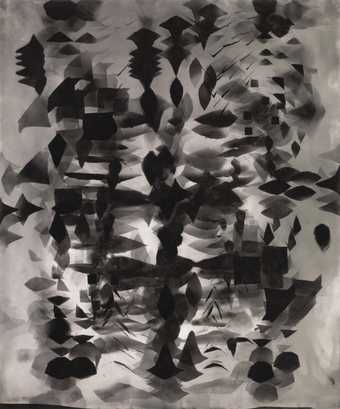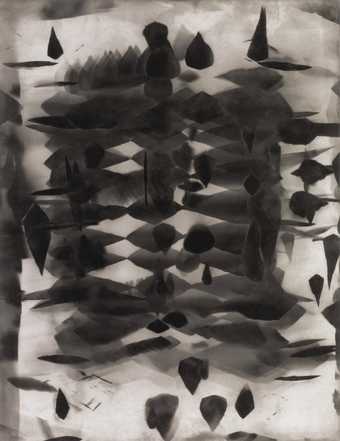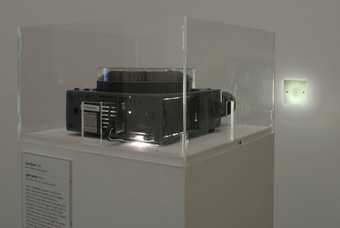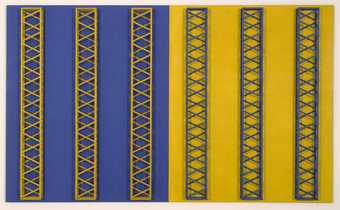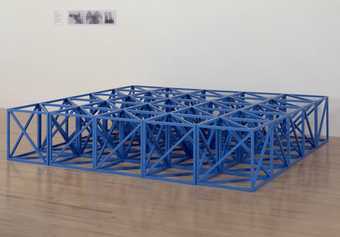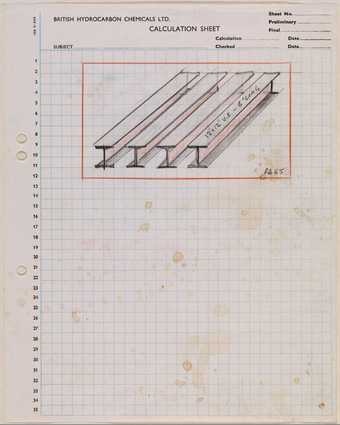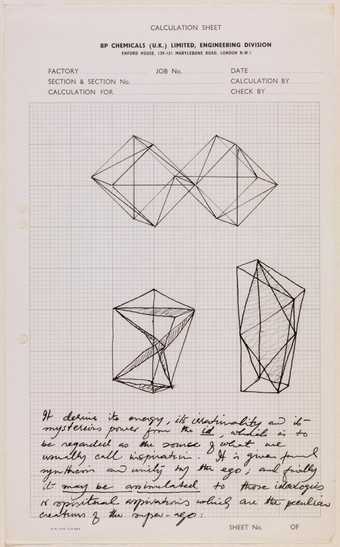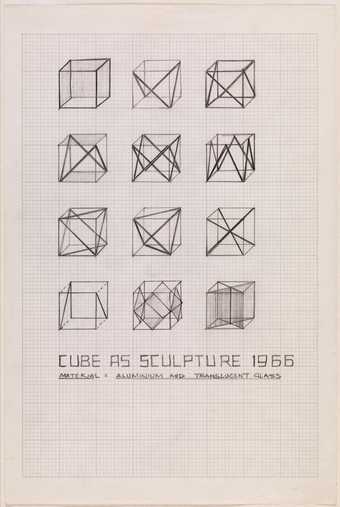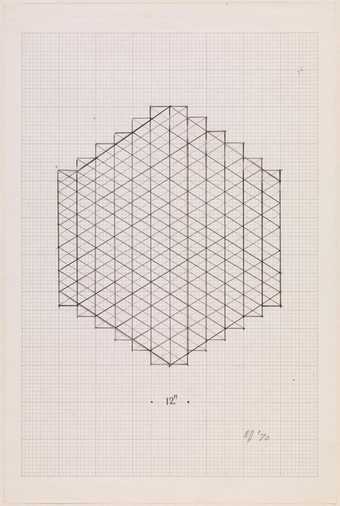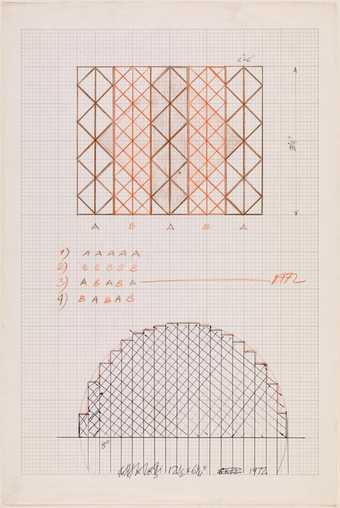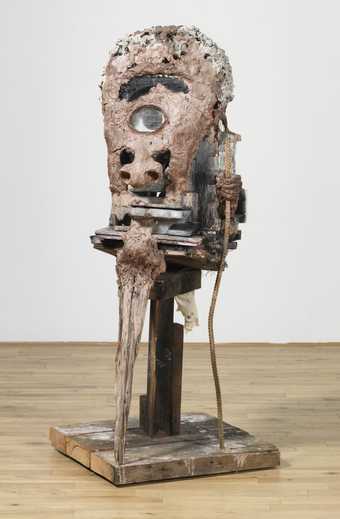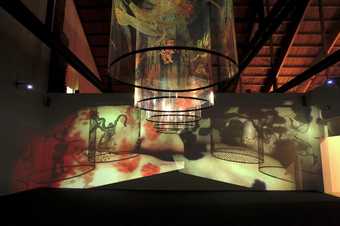
Not on display
- Artist
- Rasheed Araeen born 1935
- Medium
- 5 photographs, c-prints on paper, acrylic paint and gold paint on 4 canvases
- Dimensions
- Displayed: 1544 × 2300 mm
- Collection
- Tate
- Acquisition
- Purchased 1995
- Reference
- T06986
Summary
Born and educated in Pakistan, Araeen trained as an engineer before moving to Europe in the 1960s to become one of the pioneers of minimalist sculpture in Britain. However he received no institutional recognition for his contribution to the modernist discourse in this country, being side-lined as a non-European whose work was consistently evaluated within the context of post-colonial structures. As a result of this, in the 1970s and 1980s his work - in performance, photography, painting and sculpture - began to develop an overtly political content which drew attention to the way in which black artists were invisible within the dominant eurocentric culture. Geometric structures in which vertical and horizontal lines are held together by a network of diagonals (like the bracing struts used to strengthen latticed engineering constructions) play on the links between Eastern and Western thought and the frameworks of social institutions and aesthetics. Photographs, overlaid by or held within these geometric structures, bring in the personal and psychological and relate the human individual to the social structure in which s/he exists.
In the mid 1980s, with works such as Green Painting 1985-6 (Arts Council Collection), Araeen began to create 3 x 3 grids made up of nine panels using a combination of painted, drawn and photographic surfaces, and sometimes incorporating Arabic texts. Five panels make a central cross supported within the framework of the four corner panels. As in Bismullah these four corner panels are green, a colour which for Araeen is 'an allusion to nature/raw/ young/immature/underdeveloped/etc' (Rasheed Araeen, 1994, p.17), as well as being the main component of the Pakistani flag and an important symbolic colour in Islam. In Bismullah this reference is heightened through the addition of gold-coloured Islamic patterning, reminiscent of the decoration appearing on the walls of mosques. The four identical photographs of candles which flank the central image allude to religious ceremony for both Muslims and Christians - in fact candles and fire have universal spiritual significance. Similarly the bloodstain on the ground in the central panel suggests sacrifice and slaughter. The blood is that of a goat, ritually killed during the Muslim festival of Eid by the eldest son of the family prior to its being cooked and eaten in the meal which breaks an important religious fast. But it has much wider cultural significance, both in Christian traditions and on a primal physical level. Ritual blood-letting symbolises purification but also culturally condoned murder and the brutality of war.
The title of the piece - Bismullah - derives from the Arabic invocation 'Bismi'llah' meaning 'in the name of Allah'. Araeen's reformulation means 'in the name of the priest' making reference to a social mediation between man and his god. The spilled blood at the centre of the structure indicates the 'cutting or rupturing' of the human which seems to be the inevitable condition on which its incorporation into social structures is based. By placing material 'incongruent to the purity of minimalism' within a formal minimalist structure, Araeen has used the language of modernism to critique its cultural authority from within (Rasheed Araeen, 1994, p.17).
Further reading:
Rasheed Araeen, exhibition catalogue, South London Gallery, London 1994
From Modernism to Postmodernism: Rasheed Araeen, a retrospective: 1959-1987, exhibition catalogue, Ikon Gallery, Birmingham 1987
Rasheed Araeen: White Power, Black Sexuality, exhibition catalogue, Pentonville Gallery, London 1986
Elizabeth Manchester
May 2000
Does this text contain inaccurate information or language that you feel we should improve or change? We would like to hear from you.
Display caption
Bismullah (meaning ‘in the name of Allah’) features four green corner panels, a colour which for Araeen is ‘an allusion to nature/raw/young/immature/underdeveloped’. It is also the main component of the flag of Pakistan (where Araeen was born and educated) and an important symbolic colour in Islam. The gold-coloured Islamic patterning is reminiscent of the decorations which appear on the walls of mosques. The four groups of candles could allude to both Muslim and Christian religious ceremony, as well as having universal spiritual significance. The spilled blood at the centre of the composition indicates the ‘cutting or rupturing’ of the human. This could represent sacrifice and loss as a result of assimilation into social structures.
Gallery label, October 2022
Does this text contain inaccurate information or language that you feel we should improve or change? We would like to hear from you.
Explore
- emotions, concepts and ideas(16,416)
-
- formal qualities(12,454)
-
- photographic(4,673)
- repetition(391)
- symmetry(220)
- heating and lighting(846)
-
- candle(71)
- Judaeo-Christian imagery(856)
-
- cross(18)
- Islam(39)
- social comment(6,584)
-
- displacement(24)
- prejudice(79)
- countries(39)
You might like
-
Ceal Floyer Etching (at 45 rpm)
2000 -
Nalini Malani Untitled I
1970/2017 -
Nalini Malani Untitled III
1970/2017 -
Rasheed Araeen Fire!
1975, printed 1984 -
Ceal Floyer Light Switch
1992–9 -
Ceal Floyer Double Act
2006 -
Rasheed Araeen 3Y 3B
1969 -
Rasheed Araeen Zero to Infinity
1968–2007 -
Rasheed Araeen Drawing for Sculpture
1965 -
Rasheed Araeen Drawing for Sculpture
1968 -
Rasheed Araeen Drawing for Sculpture
1966 -
Rasheed Araeen Drawing for Sculpture
1970 -
Rasheed Araeen Drawing for Sculpture
1972 -
Huma Bhabha Man of No Importance
2006 -
Nalini Malani In Search of Vanished Blood
2012–20


